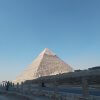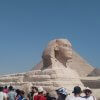*Introduction*:
Egypt is home to some of the world’s most iconic historical landmarks and attractions. This article highlights the top ten places every traveler should visit when exploring this ancient land.
Subheadings:
1. The Pyramids of Giza
*Description*:
The Pyramids of Giza, located on the outskirts of Cairo, are among the most recognizable structures in the world. The complex includes three main pyramids: Khufu (the Great Pyramid), Khafre, and Menkaure.
*Historical Significance*:
Constructed during the Fourth Dynasty of the Old Kingdom, these pyramids served as monumental tombs for the pharaohs and demonstrate the Egyptians’ architectural prowess.
*Interesting Facts*:
– The Great Pyramid is the only remaining wonder of the Seven Wonders of the Ancient World.
– Originally, the Great Pyramid stood at about 146.6 meters (481 feet) high.
*Best Time to Visit*:
October to April, when temperatures are milder.
*Tips for Tourists*:
– Arrive early to avoid crowds and the heat.
– Hire a guide for detailed historical insights.
– Wear comfortable shoes as you’ll be doing a lot of walking.
2. The Great Sphinx
*Description*:
The Great Sphinx of Giza is a limestone statue with a lion’s body and a human head, believed to represent Pharaoh Khafre.
*Historical Significance*:
Dating back to around 2500 BCE, it symbolizes strength and wisdom and guards the Giza Plateau.
*Interesting Facts*:
– The Sphinx is 73 meters (240 feet) long and 20 meters (66 feet) high.
– Its nose is missing; theories abound regarding how it was damaged.
*Best Time to Visit*:
Also best visited between October and April.
*Tips for Tourists*:
– Consider visiting during sunset for beautiful photo opportunities.
– Keep an eye on your belongings; the area can be crowded.
3. Luxor Temple
*Description*:
Luxor Temple, located in Luxor, is a large Ancient Egyptian temple complex dedicated to the rejuvenation of kingship.
*Historical Significance*:
Built primarily under Pharaoh Amenhotep III and later expanded by Ramses II, it served as a place for the annual Opet Festival.
*Interesting Facts*:
– The temple features a massive obelisk, one of a pair originally, with the other now in Paris.
– It is beautifully illuminated at night, making it a stunning sight.
*Best Time to Visit*:
November to March for cooler weather.
*Tips for Tourists*:
– Allocate enough time to explore the temple and surrounding area.
– Purchase combined tickets for access to other nearby sites.
4. Karnak Temple
*Description*:
The Karnak Temple complex is one of the largest religious structures in the world, dedicated to the god Amun and his family.
*Historical Significance*:
Construction began in the Middle Kingdom, and it continued for over a thousand years, showcasing the evolution of ancient Egyptian architecture.
*Interesting Facts*:
– The Hypostyle Hall, featuring 134 massive columns, is a highlight.
– The site covers about 100 hectares (247 acres).
*Best Time to Visit*:
Late afternoon or early morning to avoid the heat and crowds.
*Tips for Tourists*:
– Wear sunscreen and stay hydrated.
– Guided tours provide in-depth knowledge of the site’s history.
5. Valley of the Kings
*Description*:
The Valley of the Kings, located near Luxor, is a burial site for many Pharaohs and powerful nobles of the New Kingdom.
*Historical Significance*:
This site reflects the wealth and power of Egypt during the 18th to 20th dynasties and is famous for its elaborate tombs, including King Tutankhamun’s.
*Interesting Facts*:
– There are over 60 tombs discovered in the valley.
– Each tomb features stunning wall paintings that depict the journey to the afterlife.
*Best Time to Visit*:
November to March for milder temperatures.
*Tips for Tourists*:
– Some tombs require additional fees for entry; plan your visits accordingly.
– Dress appropriately for the heat and bring water.
6. Abu Simbel
*Description*:
Abu Simbel consists of two massive rock temples built during the reign of Pharaoh Ramses II, located near Lake Nasser.
*Historical Significance*:
Constructed in the 13th century BCE, these temples were intended to impress Egypt’s southern neighbors and promote Ramses’ divine status.
*Interesting Facts*:
– The Great Temple features four colossal statues of Ramses seated at its entrance.
– The temples were relocated in the 1960s to prevent flooding from the Aswan High Dam.
*Best Time to Visit*:
October to April, with early morning being the best time to avoid crowds.
*Tips for Tourists*:
– Consider booking a guided tour for deeper historical context.
– Be prepared for the remote location; plan transportation in advance.
7. The Egyptian Museum
*Description*:
The Egyptian Museum in Cairo houses an extensive collection of ancient Egyptian artifacts, including the treasures of Tutankhamun.
*Historical Significance*:
Founded in 1902, this museum is central to Egyptology and houses thousands of ancient items.
*Interesting Facts*:
– The museum contains over 120,000 artifacts, but only about 10% are on display.
– Features a mummification section that reveals the ancient burial practices.
*Best Time to Visit*:
October to April, ideally early in the day.
*Tips for Tourists*:
– Plan your visit ahead; the museum is vast.
– Consider hiring a guide for a thorough understanding of the collections.
8. The Temple of Horus at Edfu
*Description*:
The Temple of Horus, located in Edfu, is one of the best-preserved temples in Egypt, dedicated to the god Horus.
*Historical Significance*:
Construction began in 237 BCE during the Ptolemaic period and took over 180 years to complete.
*Interesting Facts*:
– The temple features intricate reliefs that depict the myth of Horus and Set.
– It is known for its massive pylons and beautifully preserved inscriptions.
*Best Time to Visit*:
Fall and spring months are ideal.
*Tips for Tourists*:
– Wear comfortable shoes for exploring the temple grounds.
– Consider visiting in the early morning or late afternoon for less heat.
9. Mount Sinai
*Description*:
Mount Sinai, a significant site for Jews, Christians, and Muslims, is where Moses is believed to have received the Ten Commandments.
*Historical Significance*:
Also known as Jebel Musa, the mountain is revered in religious traditions and attracts pilgrims from around the world.
*Interesting Facts*:
– The hike to the summit offers stunning views of the surrounding landscape.
– St. Catherine’s Monastery, located at the foot of the mountain, is one of the oldest working Christian monasteries.
*Best Time to Visit*:
October to April, with early morning hikes recommended.
*Tips for Tourists*:
– Bring plenty of water and snacks for the hike.
– Guided tours can provide valuable insights into the area’s history.
10. The Red Sea Beaches
*Description*:
The Red Sea beaches offer stunning coastal resorts and vibrant marine life, making them a paradise for sunbathers and divers alike.
*Historical Significance*:
Historically, the Red Sea served as a vital trade route and played a crucial role in Egypt’s economy and history.
*Interesting Facts*:
– The region is famous for its coral reefs, attracting scuba divers and snorkelers worldwide.
– Popular resort towns include Hurghada and Sharm El Sheikh.
*Best Time to Visit*:
March to May and September to November for pleasant weather.
*Tips for Tourists*:
– Book accommodations in advance, especially during peak seasons.
– Explore local diving schools for snorkeling and diving courses.
Conclusion
This guide provides essential information for anyone looking to visit Egypt’s iconic attractions. From ancient monuments to cultural experiences, each location offers a unique glimpse into Egyptian history and heritage. Be sure to plan your itinerary around the best times to visit and incorporate tips for an enjoyable travel experience!





